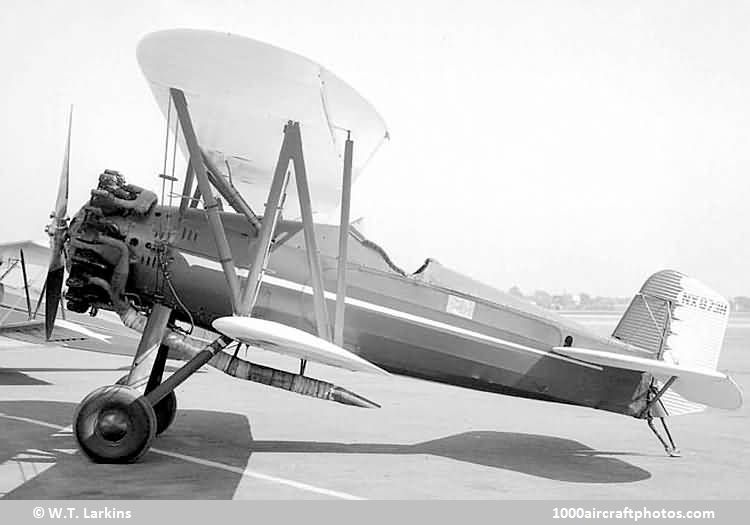12/15/2021. Remarks by Johan Visschedijk: "During the production life of the F4B/P-12 series, Boeing also manufactured a number of these aircraft for commercial or export sale. Four Model 100s were built, preceded by one two-seat Model 100A and followed by two Model 100Es and one Model 100F.
Built as a commercial version of the F4B-1, the principal Model 100 differences were the deletion of standard US military equipment and the installation of the fuel tank in the center section of the upper wing. Although essentially military airframes, the Model 100s were fully licensed under ATC 133.
The first Model 100 (c/n 1142) flew on October 8, 1929, and was sold to the Bureau of Air Commerce (now Federal Aviation Agency, or FAA) with the Government-owned-aircraft registration of NS21.
The second Model 100 (NX872H c/n 1143) is described on page 31.
Manufactured in 1929, the third Model 100 (c/n 1144) has had the most varied career and has carried every possible arrangement of US civil registration number starting with plain 873H through C, NC, NR, NX and finally N873H. It was used at the factory for several years as a test vehicle and demonstrator, and was then sent to the Boeing School of Aeronautics at Oakland, California, for use as an advanced trainer. It was acquired about 1936 by Paul Mantz and used almost continually for motion film from 1936 to 1965. After WW II, the original P&W R-1340 Wasp engine (shown above with smoke generating equipment) was replaced by a war-surplus 450 hp P&W R-985 Wasp Jr. fitted with a controllable pitch propeller.
In November 1961, Mantz and Frank Tallman merged their companies into Tallmantz Aviation Inc. After 1965, the N873H was retired from film work and kept in airworthy condition at the Movieland Museum of the Air (founded by Mantz and Tellman in 1963), and painted as a Boeing 99 F4B-1 it appeared at a number of air shows. In 1985 it was registered to Kermit A. Weeks of Polk, Florida, and still is 36 years later.
The fourth pictured Model 100 (NX874H c/n 1145) was also used as a factory test vehicle and demonstrator. During a 1931 sales program intended to sell an export version corresponding to the contemporary Army P-12D, this aircraft was temporarily assigned the designation Model 100D. While using such P-12D features as ring cowl, landing gear, and internal equipment, the 100D retained the basic 100 wing with tapered ailerons and center section fuel tank. Eventually it was sold to the Mitsui Co. of Japan.
The sole Model 100A (R247K c/n 1094) is described on page 9573.
The two Model 100Es (c/n 1487, 1488) built for Thailand were export versions of the P-12E then in production for the USAAC but could not be given the same Boeing designation of Model 234 because of government restrictions on the export of aircraft currently in production for US Services. Consequently, the basic commercial/export designation of Model 100 was applied with the suffix E added to indicate general structural, equipment, and performance similarity to the P-12E. Both 100Es were delivered on November 10, 1931, without having been assembled, flown, or photographed at the factory. The last surviving example, taken over by the Japanese during WW II, is in the Thai Aeronautical Museum at Bangkok.
The Model 100F (X10696 c/n 1681) was a commercial equivalent of the Army P-12F, delivered to Pratt & Whitney as a flying engine test bed. The standard R-1340 Wasp was replaced at the Pratt & Whitney factory by a 700 hp R-1535 Twin Wasp Jr. and the aircraft was first flown with that power plant on June 20, 1932. The higher power and lowered propeller speed of this geared engine required a propeller of unusually large diameter for an aircraft of this design, and take offs and landings with the 100F when fitted with this engine could only be made in the three-point attitude.
Like the second Model 100 (NX872H), Pratt & Whitney flew the 100F also with the Hornet engine in addition to the Wasp and Twin Wasp Jr., but the remarkable fact is that it once flew with each of the separate engines on the same day during a demonstration of quick engine-changing techniques. Because of the different engine weights, the balance of the aircraft was corrected during these engine changes by use of a sliding weight installed in the fuselage between the cockpit and the tail. On April 18, 1933, during a high-altitude test flight, the pilot became unconscious when his oxygen supply failed. The 100F fell into a spin, and the weight, which was not designed to resist such gyrations, broke loose and destroyed the controls, making recovery from the spin impossible. As all P&W test flights were performed at Rentschler Field near East Hampton, Connecticut, it is most likely the aircraft crashed near there. The fate of the pilot is not known."
